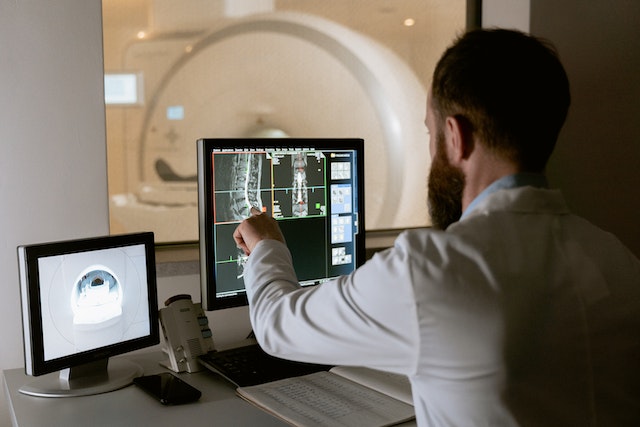PET Scan Technologist: How to Get Into This Fascinating Career
If you're looking for a career combining cutting-edge technology with hands-on patient care, becoming a PET scan technologist might be the perfect fit for you. As medical imaging advances at an unprecedented rate, so does the demand for professionals who can operate and interpret these complex machines. Along with CT and magnetic resonance imaging (MRI), PET Scans play an increasingly important role in modern healthcare. Now is an exciting time to pursue a career in this field.

This article will explore what it takes to become a PET scan technologist and why this career path is so fascinating.
What is Positron Emission Tomography (PET)?
Positron Emission Tomography (PET) is a medical imaging technique used in the field of nuclear medicine to examine various body functions and conditions. It involves using radioactive tracers injected or consumed by patients, which emit positrons that interact with electrons inside the body. A PET scanner then detects these interactions and generates an image that displays metabolic activity and blood flow in different organs.
The procedure is commonly used to diagnose illnesses like cancer, heart disease, brain disorders, and other conditions earlier than conventional imaging tools can detect. PET scans assist physicians in determining how well a patient's treatment is working based on the metabolic activity detected within their body. Moreover, it also helps determine whether cancer cells have spread from their primary location to other parts of the body.
What a PET Scan Technologist Does
As a PET scan technologist, you will have lots of responsibilities that require you to be skilled in patient care. During a PET scan procedure, the technologist will administer radioactive substances that travel through the body's cells and allow the scanner to create 3D images of the area being examined.

On top of ensuring that your patients are comfortable and informed throughout the scanning process, you must also maintain strict radiation safety protocols to protect both your patients and yourself from unnecessary exposure. This means that as a PET scan technologist, you'll need to possess excellent communication skills and be able to explain complicated medical procedures clearly and simply.
One of your primary duties as a PET scan technologist is to prepare your patients for their scans by explaining the procedure, answering questions and addressing any concerns they may have. You must also position your patient correctly within the imaging machine while making sure they feel comfortable so that accurate images can be obtained without undue radiation exposure.
Education and Training to Become a PET Technologist
If you want to become a PET Scan Technologist, you must have the right education and training. The first step is to obtain a bachelor's degree from an accredited institution with a focus on radiologic technology. This degree program should be approved by the American Registry of Radiologic Technologists (ARRT), which is the national certification organization for radiologic technologists.
In addition to your bachelor's degree, you will also need to complete specific training in positron emission tomography (PET) technology. This can include specialized courses and hours of clinical experience working with PET equipment and software. Once you have completed your coursework, you will be eligible to take the ARRT certification exam for PET technologists or the Nuclear Medicine Technologist Certification Board (NMTCB) PET exam.
Passing either exam will allow you to become certified as a PET Scan Technologist, which is required by many employers in this field.
Future Outlook of Computed Tomography
As technology continues to advance in the medical field, the demand for PET scan technologists is expected to increase. The Bureau of Labor Statistics predicts a 10% growth rate for radiologic technologists and technicians between 2018-2028. This growth rate includes increasing demand for PET scan technologists due to the aging population and advancements in medical technology.

Additionally, with the rise of precision medicine using molecular imaging techniques, there will be an even greater need for skilled PET scan technologists who can operate increasingly complex equipment and interpret results accurately.
Average Salary for PET Scan Techs
Nuclear medicine technology is rapidly growing, and PET scan technicians are in high demand. The average salary for these professionals varies based on experience, location, and the type of facility they work in. According to data from the Bureau of Labor Statistics (BLS), the median annual wage for nuclear medicine technologists – which includes PET scan techs – was $77,950 as of May 2020.
Entry-level positions typically offer lower salaries than those with more experience. However, as a PET scan tech gains experience and expertise in their field, they may be eligible for higher salaries or promotions to management positions within their facility. Geographic location also plays a role in salary expectations; states with higher costs of living tend to pay more generous wages for healthcare professionals like PET scan techs.
Finding PET Technologist Jobs
If you are a PET scan technologist looking for work, you may wonder where to begin your search. One of the most obvious places to start is diagnostic laboratories and clinics that offer PET imaging services. These organizations rely heavily on skilled technologists to operate their equipment and interpret results, so they often have openings for qualified candidates.
When searching for PET scan technologist jobs, it's important to consider the type of organization you want to work for. Diagnostic laboratories typically focus on conducting medical tests and delivering accurate results to healthcare providers, while clinics offer more comprehensive services like diagnosis and treatment. Both types of organizations can provide rewarding career opportunities for PET scan technologists, so it's worth exploring both options as part of your job search strategy.
Once you've identified potential employers in your area, be sure to review their job listings carefully.
Frequently Asked Questions About PET Technologists
What is a PET Scan Technologist?
A PET Scan Technologist is a nuclear medicine technologist who specializes in performing Positron Emission Tomography (PET) scans. They are responsible for operating PET scanners and administering radiopharmaceuticals to patients.
What is Nuclear Medicine?
Nuclear Medicine is a medical specialty that uses small amounts of radioactive materials to diagnose and treat diseases and other medical conditions. Nuclear medicine technologists are trained to use specialized equipment to administer these materials to patients and capture images of the body's internal processes.
What Credentials are Required to Become a PET Technologist?
To become a PET Technologist, you must first become certified as a Nuclear Medicine Technologist through the Nuclear Medicine Technology Certification Board (NMTCB) or the American Registry of Radiologic Technologists (ARRT). Additional certification in PET imaging may be required depending on the employer's requirements.
What is the Job Description for a PET Technologist?
A PET Technologist's job involves administering radiopharmaceuticals to patients and operating PET scanners to capture images of the body's internal processes. They are also responsible for performing quality control tests on the scanners and maintaining a safe environment for the patient and the technologist.
What Kind of Clinical Experience is Required to Become a PET Technologist?
Most employers require PET Technologists to have previous work experience in a clinical setting. This can include experience working in nuclear medicine, radiology, or other related medical fields.
What is a Radiopharmaceutical?
A radiopharmaceutical is a drug that contains a small amount of radioactive material. This material allows medical professionals to capture images of the body's internal processes and diagnose medical conditions.
What Kind of Competency is Required to Become a PET Technologist?
PET Technologists must be knowledgeable about using and operating PET scanners, radiopharmaceuticals, and other medical equipment. They must also have excellent communication and patient care skills.
What Education is Required to Become a PET Technologist?
Most PET Technologist positions require at least an associate's degree in nuclear medicine technology or a related field. Some employers may prefer candidates with a bachelor's degree.